Diesel Power Engine Market by Operation (Standby, Prime, Peak Shaving), Power Rating (Below 0.5 MW, 0.5–1 MW, 1–2 MW, 2–5 MW, and Above 5 MW), End User (Power Utilities, Industrial, Commercial, and Residential), Speed, & Region - Global Forecast to 2029
[280 Pages Report] The global diesel power engine market is estimated at USD 20.1 billion in 2024, with a projected growth to USD 25.2 billion by 2029, exhibiting a Compound Annual Growth Rate (CAGR) of 4.5%. The diesel power engine market is influenced by several key drivers that shape its growth and trajectory. Firstly, the expansion of industrialization and infrastructure development across emerging economies drives the demand for diesel power engines. These engines are vital for powering heavy machinery and equipment used in construction, mining, agriculture, and manufacturing sectors. As these industries grow and modernize, the need for reliable and efficient power sources like diesel engines increases, thereby propelling market growth. Secondly, the rising demand for backup and prime power solutions, especially in regions with unreliable or inadequate electrical grids, fuels the adoption of diesel power engines. These engines serve as dependable sources of standby power during grid outages or as primary power generators in remote areas where grid connectivity is limited. The need for continuous and uninterrupted power supply drives the deployment of diesel generators across various sectors including commercial buildings, healthcare facilities, data centers, and telecommunications networks.
The expanding transportation sector, particularly in emerging markets, contributes significantly to the demand for diesel power engines. Diesel engines are widely used in heavy-duty trucks, buses, locomotives, and marine vessels due to their high torque output and fuel efficiency. The growth of e-commerce, logistics, and freight transportation amplifies the demand for diesel-powered vehicles, further stimulating market growth. Additionally, stringent emission regulations and the pursuit of cleaner technologies are driving innovation in the diesel power engine market. Engine manufacturers are investing in research and development to develop advanced diesel engines that comply with stringent emission standards such as Euro VI, EPA Tier 4, and Bharat Stage VI. These engines incorporate technologies like selective catalytic reduction (SCR), exhaust gas recirculation (EGR), and diesel particulate filters (DPF) to reduce harmful emissions while maintaining performance and efficiency. The increasing adoption of diesel power engines in the renewable energy sector contributes to market expansion. Diesel generators are often used as backup power sources for renewable energy systems such as solar and wind farms to ensure continuous power supply during periods of low renewable energy generation or grid instability. As the deployment of renewable energy projects continues to rise globally, the demand for complementary diesel power solutions is expected to grow, driving market expansion. Therefore, the diesel power engine market is propelled by a combination of industrial growth, demand for reliable power solutions, expansion of the transportation sector, technological advancements, and integration with renewable energy systems. These drivers collectively contribute to the market's resilience and continued growth trajectory in diverse sectors and geographic regions.
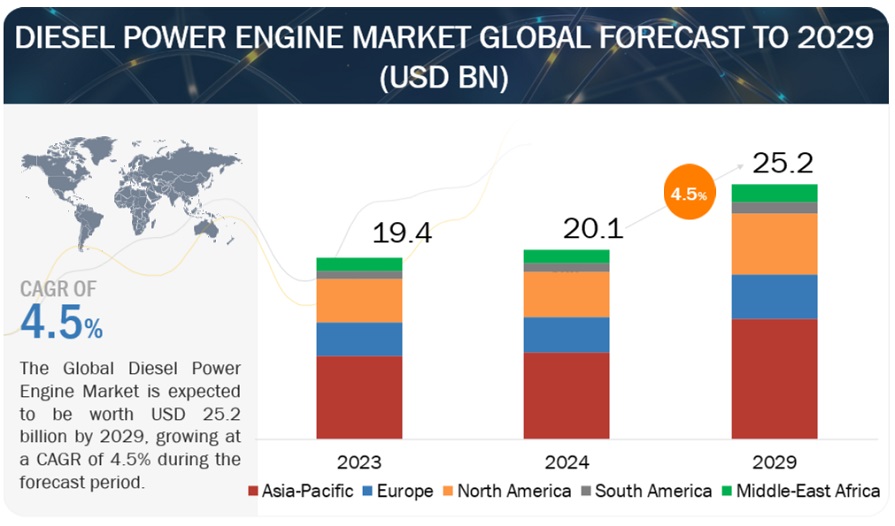
To know about the assumptions considered for the study, Request for Free Sample Report
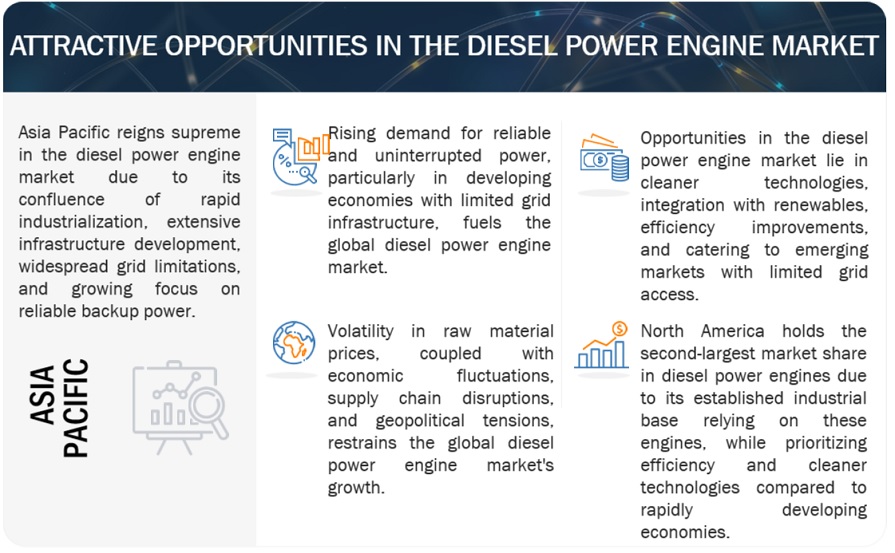
To know about the assumptions considered for the study, download the pdf brochure
Diesel Power Engine Market Dynamics
Driver: Rising demand for reliable and uninterrupted power
The rising demand for reliable and uninterrupted power supply is a significant driver fueling the growth of the diesel power engine market. In today's increasingly digitalized and interconnected world, businesses and industries rely heavily on continuous electricity supply to power their operations. Any disruption or downtime in power supply can result in significant financial losses, operational inefficiencies, and damage to critical equipment. As a result, there is a growing need for backup and prime power solutions to mitigate the impact of power outages and ensure uninterrupted operations. Diesel power engines serve as reliable sources of backup power, especially in regions prone to grid instabilities, natural disasters, or inadequate electrical infrastructure. These engines can quickly ramp up to full capacity and provide immediate power during grid failures, ensuring business continuity and safeguarding critical operations. Industries such as healthcare, telecommunications, data centers, manufacturing, and hospitality rely on diesel generators to maintain essential services and protect against revenue loss during power outages.
Moreover, diesel power engines are favored for their robustness, durability, and ability to operate continuously for extended periods without overheating or performance degradation. They are well-suited for harsh environmental conditions, remote locations, and off-grid applications where access to reliable electricity is limited. This versatility makes diesel generators indispensable for various industries, including construction sites, mining operations, oil and gas facilities, and agricultural operations, where consistent power supply is essential for productivity and safety. In addition to serving as backup power sources, diesel generators are also deployed as prime power solutions in areas with unreliable or nonexistent grid infrastructure. These engines provide a dependable and independent source of electricity for remote communities, rural areas, and off-grid installations such as telecommunications towers, irrigation systems, and remote industrial sites. In regions where access to electricity is limited or intermittent, diesel generators play a crucial role in supporting economic development, improving living standards, and enhancing quality of life. Furthermore, the increasing frequency and severity of extreme weather events, such as storms, hurricanes, and wildfires, have heightened the demand for resilient power solutions. Diesel generators offer a reliable and immediate response to emergencies, allowing businesses, governments, and communities to maintain essential services and minimize disruptions in the aftermath of natural disasters. The ability of diesel power engines to operate independently of external power sources makes them indispensable assets for disaster preparedness and recovery efforts.
Restraints: Competition from alternative power sources
Competition from alternative power sources poses a significant restraint on the global diesel power engine market. The increasing focus on sustainability, environmental regulations, and the push for decarbonization has spurred the adoption of cleaner and more sustainable energy sources such as natural gas, renewables, and energy storage solutions. As a result, diesel power engines face stiff competition from these alternative power sources, which offer lower emissions, reduced operating costs, and greater environmental benefits. Natural gas-fired generators, in particular, have emerged as a popular alternative to diesel generators due to their lower emissions profile and relatively lower fuel costs. Natural gas is considered a cleaner-burning fossil fuel compared to diesel, resulting in lower greenhouse gas emissions and air pollutants such as particulate matter, nitrogen oxides, and sulfur dioxide. Additionally, advancements in natural gas extraction technologies and infrastructure have made it more accessible and cost-effective, further driving its adoption for power generation purposes.
Renewable energy sources such as solar, wind, and hydropower also pose a competitive threat to diesel generators, especially in remote and off-grid applications. The declining costs of renewable energy technologies, coupled with government incentives and mandates to promote clean energy adoption, have accelerated the deployment of renewable energy systems worldwide. Solar photovoltaic (PV) systems, wind turbines, and micro-hydropower installations offer sustainable and emissions-free electricity generation options, reducing dependence on diesel generators in areas with ample renewable energy resources. Furthermore, advancements in energy storage technologies, such as lithium-ion batteries and flow batteries, enable the integration of intermittent renewable energy sources into the grid and provide reliable backup power solutions. Battery energy storage systems (BESS) offer fast response times, grid stabilization capabilities, and the ability to store excess renewable energy for use during periods of low generation or high demand. As battery storage costs continue to decline and energy density improves, they become increasingly competitive with diesel generators for short-duration backup power applications. The competition from alternative power sources also extends to the transportation sector, where electrification initiatives and stricter emissions regulations drive the adoption of electric vehicles (EVs) and hybrid vehicles over diesel-powered counterparts. The shift towards electric mobility reduces the demand for diesel fuel, impacting the overall diesel engine market, particularly in segments such as passenger cars, buses, and commercial vehicles.
Opportunities: Hybrid power systems integration
Hybrid power systems integration presents a significant opportunity for the global diesel power engine market. Hybrid power systems combine multiple energy sources, such as diesel generators, renewable energy sources, and energy storage systems, to optimize energy efficiency, reliability, and cost-effectiveness. By integrating diesel power engines with renewable energy sources like solar photovoltaic (PV) panels, wind turbines, or micro-hydropower systems, hybrid power systems can capitalize on the strengths of each energy source while mitigating their individual limitations. One of the key advantages of hybrid power systems is the ability to reduce fuel consumption and operating costs by leveraging renewable energy sources to offset diesel fuel usage. During periods of ample sunlight, wind, or hydro resources, renewable energy generation can supplement or even replace diesel power generation, reducing reliance on fossil fuels and lowering fuel procurement expenses. This not only improves the economic viability of off-grid and remote power systems but also contributes to environmental sustainability by reducing greenhouse gas emissions and air pollutants associated with diesel combustion.
Furthermore, hybrid power systems offer enhanced reliability and resilience by diversifying the energy sources and incorporating energy storage solutions. Energy storage systems, such as batteries or flywheels, enable the capture and storage of excess renewable energy during times of high generation for later use during periods of low renewable energy availability or high demand. This buffering capability helps stabilize power output, mitigate intermittency issues, and ensure a steady and reliable electricity supply, particularly in off-grid or unreliable grid environments. Moreover, hybrid power systems integration facilitates the adoption of advanced control and optimization algorithms to dynamically manage energy generation, storage, and consumption based on real-time data and demand fluctuations. Smart grid technologies, predictive analytics, and remote monitoring capabilities enable operators to optimize system performance, minimize fuel consumption, and maximize renewable energy utilization while ensuring reliable power delivery to end-users. This intelligent management of hybrid power systems enhances operational efficiency, reduces downtime, and improves overall system resilience and performance. The growing emphasis on energy independence, grid resiliency, and environmental sustainability drives the demand for hybrid power solutions across various sectors, including telecommunications, mining, military, and remote communities. Hybrid power systems offer a versatile and scalable solution for addressing diverse energy needs and requirements, ranging from small-scale microgrids to large-scale industrial applications. As governments, businesses, and communities seek to transition towards cleaner and more sustainable energy solutions, the demand for hybrid power systems integration is expected to grow, presenting new business opportunities for diesel engine manufacturers, renewable energy developers, and energy system integrators..
Challenges: Stricter environmental regulations
Stricter environmental regulations represent a significant restraint for the global diesel power engine market. With increasing concerns about air pollution, greenhouse gas emissions, and climate change, governments worldwide are implementing more stringent environmental standards and emission regulations to curb the environmental impact of diesel-powered equipment and machinery. These regulations typically target pollutants such as nitrogen oxides (NOx), particulate matter (PM), sulfur dioxide (SO2), and carbon dioxide (CO2) emitted by diesel engines, imposing limits on allowable emissions levels and mandating the use of emission control technologies. As a result of these regulations, diesel engine manufacturers face challenges in meeting the stringent emission standards while maintaining engine performance, fuel efficiency, and cost-effectiveness. Compliance with emissions regulations often requires the integration of advanced emission control technologies, such as selective catalytic reduction (SCR), exhaust gas recirculation (EGR), diesel particulate filters (DPF), and oxidation catalysts, into diesel engines to reduce harmful pollutants and meet regulatory requirements. However, the adoption of these emission control technologies can increase the complexity, cost, and maintenance requirements of diesel engines, posing challenges for manufacturers and end-users.
Moreover, stricter environmental regulations may lead to higher production costs, as manufacturers invest in research and development (R&D) efforts to develop cleaner and more efficient diesel engine technologies and comply with regulatory requirements. Additionally, the need for continuous innovation and investment in emission reduction technologies to stay ahead of evolving regulatory standards adds pressure on diesel engine manufacturers to remain competitive in the market while ensuring compliance with environmental regulations. These increased compliance costs and regulatory uncertainties may impact profit margins and pricing strategies, potentially affecting the overall competitiveness of diesel power engines compared to alternative power solutions. Stricter environmental regulations may influence purchasing decisions and market demand for diesel power engines, particularly in environmentally sensitive or regulated sectors such as transportation, construction, and stationary power generation. End-users may prioritize cleaner and more environmentally friendly alternatives to diesel power, such as natural gas, propane, electric, or hybrid power solutions, to minimize environmental impact and comply with regulatory requirements. This shift in demand towards alternative power solutions could result in reduced market share and sales volumes for diesel power engines, especially in regions with stringent emissions standards or carbon pricing mechanisms.
Diesel Power Engine Market Ecosystem
The market for diesel power engine is marked by the participation of leading companies that are firmly established, financially robust, and possess substantial expertise in the production of diesel power engines. These companies hold a significant market presence and provide a wide array of product offerings. They harness advanced technologies and maintain extensive global sales and marketing networks. Among the notable players in this market are Caterpillar (US), Cummins Inc. (US), WEICHAI POWER CO.,LTD (China), MAN (Germany), Rolls-Royce plc (UK), AB Volvo Penta (Sweden), MITSUBISHI HEAVY INDUSTRIES, LTD. (Japan), HD HYUNDAI INFRACORE (South Korea), DAIHATSU DIESEL MFG. CO., LTD. (Japan), YANMAR HOLDINGS CO., LTD. (Japan), KUBOTA Corporation (Japan), Kohler Energy (US), DEUTZ AG (Germany), and others.
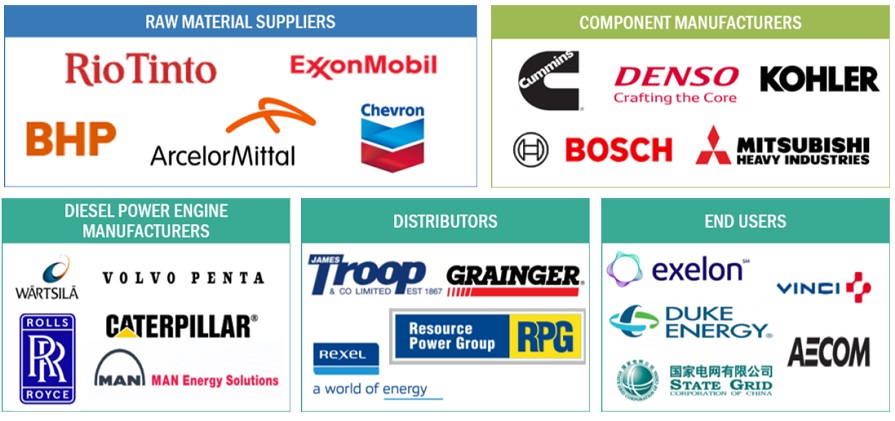
Standby segment, by operation, to have the largest market share during forecast period.
The Standby segment holds the largest market share by operation in the global diesel power engine market primarily due to its critical role in providing backup power during emergencies and outages. Standby diesel generators serve as reliable and immediate sources of power in situations where the primary grid power supply fails, ensuring uninterrupted operation of essential facilities such as hospitals, data centers, telecommunications networks, airports, and manufacturing plants. As businesses and organizations increasingly rely on uninterrupted power supply to maintain operations and safeguard critical infrastructure, the demand for standby power solutions has grown significantly, driving the dominance of the Standby segment in the diesel power engine market. One of the key drivers behind the preference for standby diesel generators is their high reliability and fast response time. Standby generators are designed to automatically start and supply power within seconds of detecting a power outage, providing seamless transition and continuous operation until grid power is restored. This rapid response capability is crucial for mission-critical applications where even momentary power interruptions can have severe consequences, such as data loss, equipment damage, productivity losses, or compromised safety and security.
Standby diesel generators offer scalability and flexibility to meet varying power requirements and application needs. These generators are available in a wide range of power ratings, from a few kilowatts to several megawatts, allowing users to select the appropriate capacity based on their specific load demands and backup power duration requirements. Moreover, standby generators can be integrated with advanced control and monitoring systems to enable remote operation, real-time diagnostics, and predictive maintenance, enhancing reliability, efficiency, and performance. The robust and durable nature of diesel engines makes them well-suited for standby power applications, particularly in harsh environments or remote locations where grid reliability may be compromised. Diesel generators can operate continuously for extended periods without degradation in performance, offering long-term reliability and low lifecycle costs compared to alternative power sources. Additionally, diesel fuel availability and infrastructure are widely established globally, ensuring consistent fuel supply and accessibility during emergencies or natural disasters when other energy sources may be unavailable.
Above 1000 RPM segment, by speed, to emerge as largest segment of diesel power engine market.
The Above 1000 RPM segment by speed holds the largest market share in the global diesel power engine market primarily due to its widespread adoption in various high-speed applications and industries where efficiency, power density, and compact size are paramount. Diesel engines operating at speeds above 1000 RPM offer several advantages that make them preferred choices for a wide range of applications, including automotive, marine, construction, agriculture, and industrial equipment. One of the key factors driving the dominance of the Above 1000 RPM segment is the superior power-to-weight ratio and energy efficiency offered by high-speed diesel engines. These engines are capable of delivering higher power outputs relative to their size and weight compared to low-speed counterparts, making them ideal for applications where space and weight constraints are critical considerations, such as automotive vehicles, compact machinery, and portable power units. The compact size and lightweight design of high-speed diesel engines enable their integration into smaller equipment and systems without compromising performance or efficiency.
Diesel engines operating at speeds above 1000 RPM exhibit excellent dynamic response and throttle control, allowing for rapid acceleration, deceleration, and precise power modulation in dynamic operating conditions. This responsiveness is particularly advantageous in applications requiring frequent load changes, variable speed operation, or precise power delivery, such as vehicles, generators, pumps, compressors, and propulsion systems. The ability of high-speed diesel engines to quickly adjust to varying loads and operating conditions enhances overall system performance, productivity, and operational flexibility. Furthermore, the Above 1000 RPM segment offers a wide range of power ratings and configurations to accommodate diverse application requirements and performance specifications. High-speed diesel engines are available in various cylinder configurations, turbocharged or supercharged designs, and fuel injection systems, allowing manufacturers to tailor engine designs to specific application needs, operating environments, and regulatory standards. This versatility and customization capability make high-speed diesel engines suitable for a broad spectrum of industries and end-users seeking reliable, high-performance power solutions. Advancements in engine design, materials, combustion technology, and emissions control have further enhanced the efficiency, reliability, and environmental performance of high-speed diesel engines, driving their adoption across industries and regions. Modern high-speed diesel engines incorporate advanced features such as electronic controls, common rail fuel injection, variable geometry turbocharging, and exhaust aftertreatment systems to optimize fuel efficiency, reduce emissions, and comply with stringent regulatory requirements for air quality and greenhouse gas emissions.
Power Utilites segment, by End User, to hold the largest market share in diesel power engine market.
The Power Utilities segment likely holds the largest market share by end user in the global diesel power engine market due to several crucial factors. Utilities require large, high-output diesel engines for continuous electricity generation. These engines power entire grids or major substations, ensuring a steady supply of electricity to homes and businesses. The sheer volume and power output of these engines for large-scale generation contribute significantly to the market share. Power utilities utilize diesel engines for both baseload and peak power generation. Baseload refers to the constant minimum level of electricity required to meet consumer demand. Diesel engines can be efficient for baseload power in remote areas or as a supplement to renewable energy sources during low generation periods. Additionally, utilities rely on diesel engines during peak demand periods to meet surges in electricity consumption and prevent blackouts. Power grids are not always expansive, and some regions lack grid infrastructure entirely. In these scenarios, power utilities deploy diesel engines for off-grid power generation, supplying electricity to remote communities and industrial facilities. While renewable energy sources like solar and wind power are gaining traction, they are intermittent. Diesel engines can provide crucial backup power and grid stabilization during periods of low renewable energy generation, ensuring a reliable and balanced electricity supply. While other segments like industrial and commercial utilize diesel engines, the sheer volume and power output of engines required by power utilities for continuous baseload, peak power generation, off-grid applications, and grid resilience solidify their position as the largest market share holder in the global diesel power engine market.
The Asia Pacific diesel power engine market is poised to achieve the highest CAGR throughout the forecast period.
Asia Pacific holds the largest market share in the global diesel power engine market primarily due to several key factors driving demand for diesel engines across various industries and applications in the region. One of the main drivers is the rapid industrialization and urbanization witnessed across Asia Pacific countries, leading to robust growth in construction, manufacturing, infrastructure development, and transportation sectors. Diesel engines play a crucial role in powering heavy-duty machinery, construction equipment, commercial vehicles, and generators required for these activities, driving significant demand for diesel power solutions. The expanding population, rising energy consumption, and increasing demand for reliable electricity supply in remote or off-grid areas have fueled the deployment of diesel generators for backup power generation, grid stabilization, and decentralized energy solutions in Asia Pacific countries. Diesel generators are widely used in residential, commercial, industrial, and institutional settings to ensure uninterrupted power supply during grid outages, peak demand periods, or in areas with limited access to centralized electricity grids, thereby driving substantial demand for diesel power engines in the region.
The agriculture sector in Asia Pacific heavily relies on diesel-powered machinery and equipment for various agricultural activities such as plowing, planting, harvesting, irrigation, and transportation. Diesel engines are preferred for their robustness, fuel efficiency, torque, and reliability, making them indispensable for mechanized farming operations across the region. The agricultural machinery market in Asia Pacific is experiencing steady growth due to increasing mechanization, adoption of modern farming techniques, and government initiatives to enhance agricultural productivity and rural livelihoods, further boosting demand for diesel power engines. Asia Pacific countries are investing in infrastructure development, renewable energy integration, and electrification initiatives to support economic growth, enhance energy security, and mitigate environmental challenges. While there is a growing emphasis on transitioning to cleaner energy sources and reducing greenhouse gas emissions, diesel power engines continue to play a vital role in supporting critical infrastructure, backup power systems, and remote applications where grid connectivity or renewable energy alternatives are limited or unreliable.
The presence of leading diesel engine manufacturers, extensive distribution networks, and technological advancements in engine design, performance, and emissions control systems have contributed to the widespread adoption of diesel power solutions in Asia Pacific. Manufacturers are continuously innovating to develop more efficient, reliable, and environmentally friendly diesel engines that comply with stringent emission standards and regulatory requirements while meeting the diverse needs of customers across different industries and applications in the region. Hence, the combination of industrial growth, urban development, infrastructure expansion, agricultural mechanization, energy demand, and technological advancements has propelled Asia Pacific to become the largest market for diesel power engines globally. With continued investments in infrastructure, energy, and manufacturing sectors, coupled with rising demand for reliable power solutions, Asia Pacific is expected to maintain its dominant position in the global diesel power engine market in the foreseeable future.
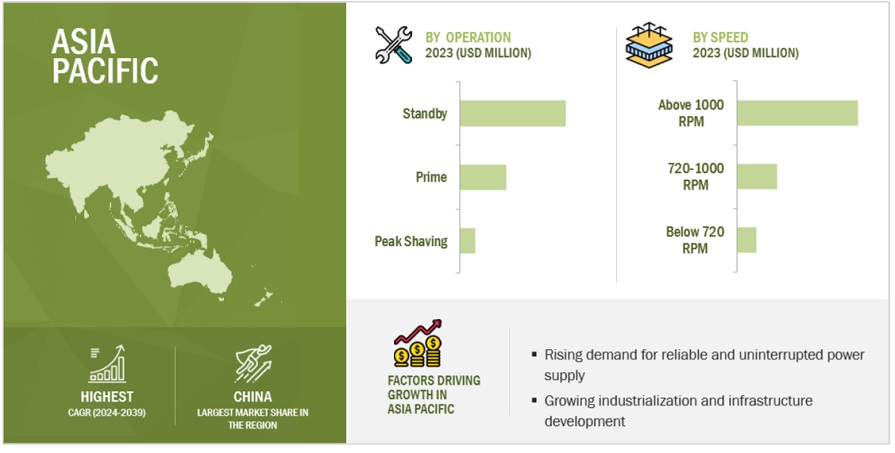
Key Market Players
Caterpillar (US), Cummins Inc. (US), WEICHAI POWER CO.,LTD (China), MAN (Germany), Rolls-Royce plc (UK), AB Volvo Penta (Sweden), MITSUBISHI HEAVY INDUSTRIES, LTD. (Japan), HD HYUNDAI INFRACORE (South Korea), DAIHATSU DIESEL MFG. CO., LTD. (Japan), YANMAR HOLDINGS CO., LTD. (Japan), KUBOTA Corporation (Japan)
Get online access to the report on the World's First Market Intelligence Cloud
- Easy to Download Historical Data & Forecast Numbers
- Company Analysis Dashboard for high growth potential opportunities
- Research Analyst Access for customization & queries
- Competitor Analysis with Interactive dashboard
- Latest News, Updates & Trend analysis
Request Sample Scope of the Report
Get online access to the report on the World's First Market Intelligence Cloud
- Easy to Download Historical Data & Forecast Numbers
- Company Analysis Dashboard for high growth potential opportunities
- Research Analyst Access for customization & queries
- Competitor Analysis with Interactive dashboard
- Latest News, Updates & Trend analysis
|
Report Metric |
Details |
|
Market Size available for years |
2020–2029 |
|
Base year considered |
2023 |
|
Forecast period |
2024–2029 |
|
Forecast units |
Value (USD Million) |
|
Segments covered |
By Operation, By Power Rating, By Speed, By End User |
|
Geographies covered |
Asia Pacific, North America, Europe, Middle East and Africa, and South America |
|
Companies covered |
Caterpillar (US), Cummins Inc. (US), WEICHAI POWER CO.,LTD (China), MAN (Germany), Rolls-Royce plc (UK), AB Volvo Penta (Sweden), MITSUBISHI HEAVY INDUSTRIES, LTD. (Japan), HD HYUNDAI INFRACORE (South Korea), DAIHATSU DIESEL MFG. CO., LTD. (Japan), YANMAR HOLDINGS CO., LTD. (Japan), KUBOTA Corporation (Japan), Kohler Energy (US), DEUTZ AG (Germany), Mahindra&Mahindra Ltd. (India), IHI Power Systems Co.,Ltd (Japan), Guangzhou diesel engine factory Limited (China). |
The diesel power engine market is classified in this research report based on operation,, power rating, speed, end user, and region.
Based on operation, the diesel power engine market has been segmented as follows:
- Standby
- Prime
- Peak shaving
Based on power rating, the diesel power engine market has been segmented as follows:
- Below 0.5 MW
- 0.5-1 MW
- 1-2 MW
- 2-5 MW
- Abovw 2-5 MW
Based on speed, the diesel power engine market has been segmented as follows:
- Below 720 RPM
- 720-1000 RPM
- Above 1000 RPM
Based on End User, the diesel power engine market has been segmented as follows:
- Power Utilities
- Industrial
- Commercial
- Residential
Based on regions, the distribution transformer market has been segmented as follows:
- North America
- Asia Pacific
- South America
- Europe
- Middle East and Africa
Recent Developments
- In April 2024, Rolls-Royce, ASCO Carbon Dioxide Ltd (ASCO), and Landmark Power Holdings Limited (LMPH), have signed an agreement aimed at developing scalable solutions for clean power generation with carbon capture from mtu engines.
- In March 2024, Caterpillar has come into a partnership with Africa Data Centres Association (ADCA), where Caterpillar’s power solutions will offer efficient diesel and gas generator sets with high power densities with specifically customized for continuous, standby, and temporary power applications at data centres.
- In April 2023, Cummins announced that in addition to recent investments in Fridley, the company is investing more than (USD 1 billion) across its U.S. engine manufacturing network in Indiana, North Carolina, and New York.
Frequently Asked Questions (FAQ):
What is the current size of the global diesel power engine market?
The global diesel power engine market is estimated to be USD 20.1 billion in 2024.
What are the major challenges for diesel power engine market?
The global diesel power engine market faces several major challenges, including stringent environmental regulations aimed at reducing greenhouse gas emissions and pollutants, which necessitate costly investments in advanced emissions control technologies and compliance measures. Additionally, the rising adoption of alternative energy sources such as solar, wind, and natural gas, coupled with the increasing integration of hybrid and renewable power systems, poses significant competition to traditional diesel engines. Furthermore, fluctuating fuel prices and supply chain disruptions can impact the overall cost-effectiveness and reliability of diesel power solutions. Lastly, advancements in battery storage and electric powertrain technologies are gradually eroding the market share of diesel engines in various applications, particularly in transportation and backup power sectors, presenting a formidable challenge to the growth of the global diesel power engine market.
Which segment by operation has the largest market share in the diesel power engine market?
The standby segment by operation holds the largest market share in the global diesel power engine market primarily due to the critical need for reliable backup power across various sectors, including healthcare, data centers, telecommunications, and industrial facilities. These applications require uninterrupted power to ensure operational continuity and safeguard against power outages, making diesel engines an ideal choice for their robustness and quick response capabilities. The growing frequency of power grid failures and natural disasters further drives the demand for standby diesel generators. Additionally, advancements in technology have enhanced the efficiency and reliability of standby diesel power systems, making them a preferred option for emergency power solutions.
Which region holds largest market share in the diesel power engine market?
Asia Pacific holds the largest market share in the global diesel power engine market due to the region's rapid industrialization, urbanization, and significant infrastructure development. Countries like China, India, and Japan are experiencing substantial growth in their manufacturing sectors, which drives the demand for reliable and efficient power solutions. Additionally, the region's expanding construction activities, burgeoning telecommunications industry, and increasing need for backup power in residential and commercial spaces contribute to the high demand for diesel power engines. Government initiatives aimed at improving rural electrification and the frequent occurrence of power outages also bolster the market. Furthermore, Asia Pacific's growing population and rising energy consumption necessitate robust and dependable power generation solutions, solidifying the region's dominant market position.
Which is the largest segment, by speed in the diesel power engine market during the forecast period?
The Above 1000 RPM segment holds the largest market share in the global diesel power engine market due to its superior performance and efficiency in high-demand applications. These high-speed engines are favored for their ability to deliver significant power output in a compact size, making them ideal for use in a variety of industries including power generation, marine, and construction. Their ability to handle fluctuating loads and provide quick startup times is particularly valuable in emergency power supply and backup power systems. Additionally, advancements in technology have enhanced the durability and fuel efficiency of high-speed diesel engines, further driving their adoption across sectors that require reliable and uninterrupted power. .
To speak to our analyst for a discussion on the above findings, click Speak to Analyst
This study encompassed significant efforts in determining the present size of the diesel power engine market. It commenced with a thorough secondary research process to gather data related to the market, similar markets, and the overarching industry. Subsequently, these findings, assumptions, and market size calculations were rigorously validated by consulting industry experts across the entire supply chain through primary research. The total market size was assessed by conducting an analysis specific to each country. Following that, the market was further dissected, and the data was cross-referenced to estimate the size of various segments and sub-segments within the market.
Secondary Research
In this research study, a wide range of secondary sources were utilized, including directories, databases, and reputable references such as Hoover's, Bloomberg BusinessWeek, Factiva, World Bank, International Monetary Fund (IMF), the US Department of Energy (DOE), and the International Energy Agency (IEA). These sources played a crucial role in gathering valuable data for a comprehensive analysis of the global diesel power engine market, covering technical, market-oriented, and commercial aspects. Additional secondary sources included annual reports, press releases, investor presentations, whitepapers, authoritative publications, articles authored by well-respected experts, information from industry associations, trade directories, and various database resources.
Primary Research
The diesel power engine market involves a range of stakeholders, including raw material suppliers, component manufacturers, diesel power engine manufacturers/assemblers, distributors, end users, and post-sale services within the supply chain. The demand for this market is primarily driven by end users such as power utilities, residential & commercial. On the supply side, there is a notable trend of heightened demand for contracts from the industrial sector and a significant presence of investments and expansions among major players.
To gather qualitative and quantitative insights, various primary sources from both the supply and demand sides of the market were interviewed. The following breakdown presents the primary respondents involved in the research study.
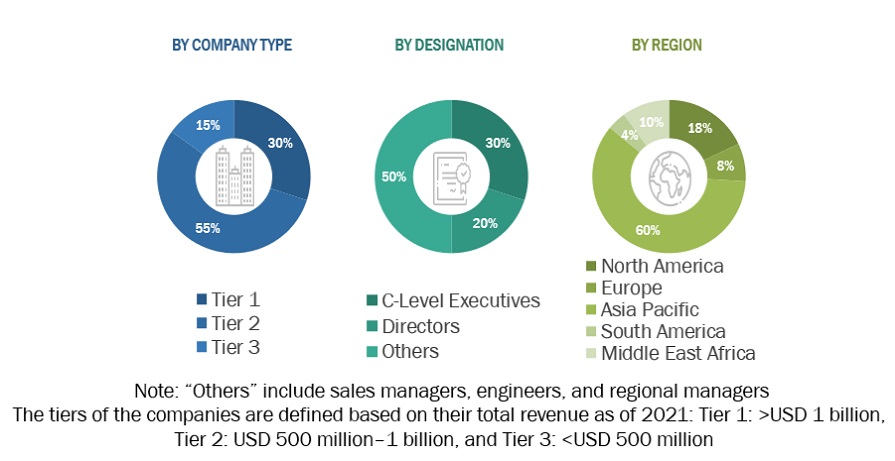
To know about the assumptions considered for the study, download the pdf brochure
Market Size Estimation
The estimation and validation of the diesel power engine market size have been conducted using a bottom-up approach. This approach was rigorously employed to ascertain the dimensions of multiple subsegments within the market. The research process comprises the following key stages.
In this method, the production statistics for each type of diesel power engine have been examined at both the country and regional levels.
Thorough secondary and primary research has been conducted to gain a comprehensive understanding of the global market landscape for various segments of diesel power engines.
Numerous primary interviews have been undertaken with key experts in the field of diesel power engine development, encompassing important OEMs and Tier I suppliers.
When calculating and forecasting the market size, qualitative factors such as market drivers, limitations, opportunities, and challenges have been taken into account.
Global Diesel Power Engine Market Size: Bottom-Up Approach
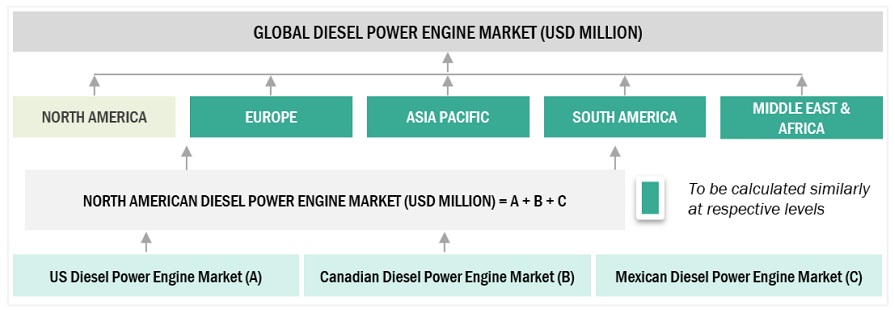
To know about the assumptions considered for the study, Request for Free Sample Report
Data Triangulation
The process of determining the overall market size involved the methodologies described earlier, followed by segmenting the market into multiple segments and subsegments. To finalize the comprehensive market analysis and obtain precise statistics for each market segment and subsegment, data triangulation and market segmentation techniques were applied, as appropriate. Data triangulation was accomplished by examining various factors and trends from both the demand and supply perspectives within the ecosystem of the diesel power engine market.
Market Definition
A diesel power engine is an internal combustion engine that operates on the principle of compression ignition. It uses diesel fuel, a type of petroleum-derived liquid fuel, as its primary source of energy. In a diesel engine, air is compressed within the combustion chamber to a high temperature, causing the diesel fuel to ignite spontaneously upon injection into the chamber. This combustion process generates mechanical energy, which is harnessed to drive various applications such as vehicles, generators, construction equipment, marine vessels, and industrial machinery. Diesel engines are renowned for their fuel efficiency, durability, and high torque output, making them widely used across diverse industries for both stationary and mobile power generation.
Key Stakeholders
- Government & research organizations
- Institutional investors
- Investors/shareholders
- Environmental research institutes
- Manufacturers’ associations
- Diesel power engine raw material and component manufacturers
- Diesel power engine manufacturers, dealers, and suppliers
- State and national regulatory authorities
- Manufacturing industry
- Energy efficiency consultancies
- Smart grid project developers
- Public & private power generation, transmission & distribution companies (utilities)
- Sub-station equipment manufacturing companies
Objectives of the Study
- To describe and forecast the diesel power engine market, in terms of value, by operation, power rating, speed, end user, and region
- To forecast the market for various segments, in terms of value, with regard to five regions: North America, South America, Europe, Asia Pacific, and the Middle East & Africa, along with their key countries
- To provide detailed information about the key factors, such as drivers, restraints, opportunities, and challenges, influencing the market’s growth
- To strategically analyze the subsegments with respect to individual growth trends, prospects, and contributions of each segment to the overall market size
- To study the complete supply chain and allied industry segments and perform a supply chain analysis of the diesel power engine landscape
- To strategically analyze the regulatory landscape, tariff, standards, patents, Porter’s five forces, import and export scenarios, trade values, and case studies pertaining to the market under study
- To analyze the opportunities in the market for various stakeholders by identifying the high-growth segments of the diesel power engine market
- To profile the key players and comprehensively analyze their market position in terms of ranking and core competencies1, along with detailing the competitive landscape for the market leaders
- To analyze competitive developments such as agreements, partnerships, product launches, acquisitions, contracts, expansions, and investments in the diesel power engine market
Available Customization
With the given market data, MarketsandMarkets offers customizations based on the company’s specific needs. The following customization options are available for the report:
Product Analysis
- Product Matrix, which provides a detailed comparison of the product portfolio of each company
Company Information
- Detailed analyses and profiling of additional market players (up to 5)












Growth opportunities and latent adjacency in Diesel Power Engine Market